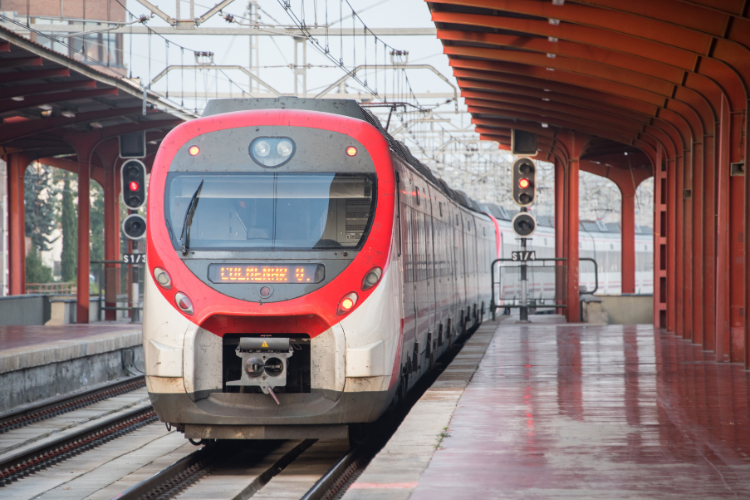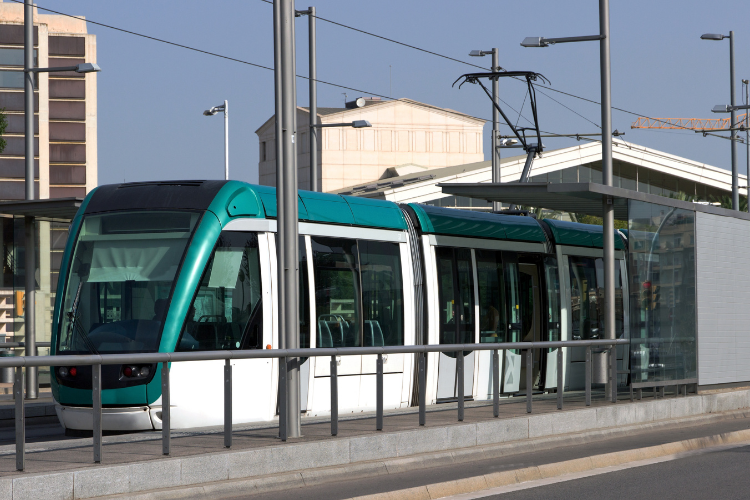Last Updated on November 1, 2024 by Maryam Siddiqui
Public transport in Spain offers an efficient and economical way to navigate its vibrant cities and picturesque countryside. Understanding how to use public transport in Spain can enhance your travel experience.

This is the reality, whether you’re visiting for the first time or settling down, and understanding how to use public transport in Spain can enhance your travel experience. From Madrid’s awe-inspiring metros to Zaragoza’s trams, Spain’s public transport system is designed to serve both locals and tourists.
This guide will explore various transportation modes, their costs, and how to make the most of Spain’s public transit systems.
Is Public Transport in Spain Good?
Public transport in Spain ranks highly compared to other European countries, offering extensive and reliable services. According to Numbeo, Spain’s public transportation system is considered efficient and affordable.
For instance, a monthly pass in Madrid costs around €54.60.
The extensive network of buses, trams, and trains ensures that almost every corner of the cities is accessible, making it easier for residents and visitors to commute.
Spain’s investment in public transport infrastructure has resulted in modern, clean, and punctual services.
Cities like Barcelona and Madrid boast some of Europe’s most advanced metro systems, with regular maintenance and upgrades ensuring smooth operations.
Metro in Spain
Spain boasts impressive metro systems in its largest cities, providing a quick and convenient way to travel.
The metro systems in cities like Madrid, Barcelona, Valencia, and Bilbao are well-developed, making them a cornerstone of urban mobility.
These underground networks alleviate surface traffic and offer a speedy alternative to buses and trams.
Madrid Metro
Madrid’s metro is one of the most extensive in the world, with over 300 kilometers of track and 13 lines.
It covers a vast area of the city, ensuring that residents and visitors can travel efficiently between different neighborhoods. The metro system is known for its punctuality and frequency, with trains running every few minutes during peak hours. Stations are equipped with modern amenities, including Wi-Fi and accessibility features for people with disabilities.
The metro system in Madrid also includes suburban trains (Cercanías) that connect the city center with surrounding towns and suburbs.
This integration allows for seamless travel across the greater Madrid region.
Barcelona Metro
The Barcelona metro system, though smaller than Madrid’s, is highly efficient with 12 lines covering 146 kilometers.
It is an integral part of the city’s public transport network, serving millions of passengers annually. The metro is known for its cleanliness, safety, and reliability. Stations are strategically located near major attractions, business districts, and residential areas, making daily commutes and tourist visits convenient.
The Barcelona Metro also includes an extensive night service, ensuring that people can travel safely even during late hours. This feature is particularly beneficial in a city known for its vibrant nightlife.
Additionally, the metro system is continually upgraded, with new trains and technologies being introduced to enhance passenger comfort and reduce travel times. Integrating the metro with other forms of public transport, such as buses and trams, further enhances its efficiency.
Valencia Metro
Valencia’s metro includes underground and tram services, ensuring comprehensive coverage of the city. The metro system is relatively new, with modern trains and stations that provide a comfortable travel experience.
Valencia Metro connects key areas of the city, including the airport, making it a convenient option for travelers. The metro network is designed to be user-friendly, with clear signage and multilingual information available to assist non-Spanish speakers.
Valencia’s public transport authority continually works to expand and improve the metro system.
Bilbao Metro
Bilbao’s modern metro system is smaller but integrates well with other forms of transport. The metro consists of three lines that cover the city and its suburbs, providing an essential service for daily commuters.
Bilbao Metro is known for its architectural design, with stations designed by renowned architect Norman Foster.
This aesthetic appeal, combined with functionality, makes the Bilbao Metro a unique and pleasant experience for passengers.
The metro system in Bilbao is continuously expanding, with plans to add new lines and stations in the coming years.
Buses in Spain
Buses are a vital component of public transport in Spain, serving urban and rural areas. They offer flexibility and reach places not accessible by metro or trains.
Spanish cities have extensive bus networks, ensuring that almost every neighborhood is connected. Here’s a breakdown of bus ticket costs in various cities:
| City | Single Ticket | Monthly Pass |
|---|---|---|
| Madrid | €1.50 | €54.60 |
| Barcelona | €2.40 | €54.00 |
| Valencia | €1.50 | €45.00 |
| Seville | €1.40 | €35.00 |
Buses in Spain are known for their frequency and coverage, making them a reliable option for daily commuting and intercity travel.
The bus networks are designed to complement other forms of public transport, providing last-mile connectivity and access to areas not served by metro or trams.
Most cities offer night bus services, ensuring safe travel options during late hours.
Urban Bus Services
Urban bus services are essential for daily commuting within cities.
They connect residential areas with business districts, shopping centers, and major attractions. The frequency of buses varies depending on the time of day, with more frequent services during peak hours. Bus stops are conveniently located, and buses are equipped with modern amenities such as Wi-Fi, air conditioning, and accessibility features for people with disabilities.
Intercity Buses
Intercity buses provide an affordable and convenient way to travel between different cities and towns in Spain.
Companies like ALSA and Avanza offer extensive networks covering almost the entire country.
These buses are equipped with comfortable seating, onboard entertainment, and restrooms, ensuring a pleasant travel experience. Ticket prices for intercity buses are generally lower than train tickets, making them a popular choice for budget travelers.
Airport Buses
Many Spanish cities have dedicated airport bus services that connect the city center with the airport. These buses offer a convenient and cost-effective alternative to taxis and private transfers.
Airport buses are designed to accommodate passengers with luggage and run frequently to match flight schedules. They provide a reliable option for both residents and tourists traveling to and from the airport.
Trams in Spain
Trams are another popular mode of public transport in Spain, especially in cities like Barcelona, Valencia, and Zaragoza.
They offer a smooth and scenic way to travel within cities, with extensive networks covering key areas. They are an eco-friendly alternative to buses and cars, contributing to reduced traffic congestion and pollution.
Trams in Barcelona
Barcelona’s tram network consists of six lines, providing extensive coverage. A single ticket costs around €2.40.
The trams in Barcelona are modern and well-maintained, offering a comfortable travel experience.
They connect major residential areas with business districts, shopping centers, and tourist attractions. The tram network is integrated with other forms of public transport, allowing passengers to switch seamlessly between trams, buses, and the metro.
Trams in Valencia
Valencia’s tram system is integrated with its metro, with single tickets costing approximately €1.50. The trams provide a reliable and efficient way to travel within the city, covering areas not served by the metro.
Valencia’s trams are known for their punctuality and frequency, ensuring passengers can travel conveniently.
The tram network is continually expanding, with new lines added to enhance coverage.
Trams in Zaragoza
Zaragoza features a modern tram system with single tickets priced at about €1.35. The trams in Zaragoza are designed to be eco-friendly, with initiatives to reduce energy consumption and promote sustainable travel.
The tram network covers key areas of the city, providing a reliable alternative to buses and cars.
Zaragoza’s trams are integrated with other public transport options, ensuring seamless connectivity and efficient travel.
Trains in Spain
Spain’s train network is renowned for its efficiency, connecting cities and towns nationwide. The country boasts one of the best high-speed rail networks in the world, with trains reaching up to 310 km/h. Here’s a list of typical train ticket costs:
- Madrid to Barcelona: Starting at €40
- Valencia to Seville: Starting at €30
- Bilbao to Madrid: Starting at €25

High-Speed Trains
The high-speed AVE trains connect major cities like Madrid, Barcelona, Seville, and Valencia. These trains offer a fast and comfortable way to travel long distances, with journey times significantly reduced compared to conventional trains. AVE trains have modern amenities, including Wi-Fi, onboard entertainment, and dining services.
Regional Trains
Regional trains connect smaller towns and cities with the major urban centers. They offer a more affordable alternative to high-speed trains, with tickets priced lower. Regional trains are essential for daily commuting and provide reliable services with frequent schedules. The trains are designed to be comfortable, with spacious seating and modern facilities.
Suburban Trains
Suburban trains, known as Cercanías, operate in major metropolitan areas, connecting the city center with suburbs and nearby towns. These trains are crucial for daily commuting and offer frequent services during peak hours. Cercanías trains are integrated with other forms of public transport, providing seamless connectivity for passengers.
Let’s Move to Europe
With Viv Europe your plans for Europe will come to a reality
Bicycle Sharing
Bicycle sharing is gaining popularity in Spanish cities, offering an eco-friendly and healthy alternative to motorized transport. Programs like Bicing in Barcelona and Sevici in Seville provide affordable and convenient options for short-distance travel.
Bicing in Barcelona
Bicing is Barcelona’s public bike-sharing program. Thousands of bicycles are available at stations across the city. Users can rent a bike for short periods, making it ideal for commuting or leisure rides.
The program is designed to be user-friendly, with easy registration and payment options. Bicing promotes sustainable travel and reduces traffic congestion in the city.
Sevici in Seville
Sevici is Seville’s bike-sharing program, offering a convenient way to travel within the city.
The program has numerous stations, ensuring users can easily find and return bikes. Sevici bikes are well-maintained and equipped with features like adjustable seats and baskets.
The program encourages residents and visitors to adopt a healthy and eco-friendly mode of transport.
Other Cities
Many other Spanish cities, including Valencia and Zaragoza, have implemented bike-sharing programs.
These programs are part of broader initiatives to promote sustainable urban mobility.
They provide an affordable and efficient alternative to cars and public transport, contributing to reduced traffic and pollution.
Public Transport Cards in Spain
Public transport cards offer convenience and savings for regular commuters. They provide unlimited travel on various modes of transport, including buses, metros, and trams.
Here’s a look at the cost of public transport cards in Spain, courtesy of Introducing Madrid:
- Madrid: Monthly card costs €54.60
- Barcelona: Monthly card costs €54.00
- Valencia: Monthly card costs €45.00
Benefits of Transport Cards
Public transport cards offer several benefits, including cost savings, convenience, and flexibility.
They allow unlimited travel within the designated zones, making them ideal for daily commuting.
Transport cards are easy to use, with options for monthly or annual subscriptions. They also eliminate the need to purchase individual tickets for each journey.

How to Obtain a Transport Card
Obtaining a public transport card in Spain is straightforward. Residents can apply online or visit designated offices to register.
The process typically requires proof of identity and residence.
Once registered, users receive a physical card or a digital pass that can be used on various modes of transport. Transport cards can be recharged online or at designated kiosks.
Using a Transport Card
Using a transport card is simple and convenient. Passengers can swipe their cards at ticket barriers or on buses and trams to access the services.
The card automatically tracks usage and ensures that passengers can travel without the hassle of purchasing individual tickets.
Transport cards are valid for various modes of transport, providing seamless connectivity and efficient travel.
Which Spanish Cities Have the Best Transport System?
Are you curious as to which Spanish city has the best transport system? Check out our exhaustive list below!
Public Transport in Madrid
Madrid’s comprehensive metro and bus systems make it one of the best cities for public transport in Spain.
Compared to other Spanish cities, Madrid offers more extensive coverage and frequent services. The metro system is particularly impressive, with over 300 kilometers of track and 13 lines. Madrid also boasts an extensive bus network, providing reliable services to almost every corner of the city.
Madrid’s public transport system is known for its efficiency and punctuality. Integrating metro, bus, and suburban train services ensures seamless connectivity for passengers.
Public Transport in Barcelona
Barcelona’s metro, bus, and tram services are highly efficient, with frequent schedules and extensive routes. Compared to cities like Seville, Barcelona’s public transport is more integrated and user-friendly.
The metro system covers key areas of the city, ensuring convenient access to major attractions, business districts, and residential neighborhoods. Barcelona also offers an extensive bus network, providing reliable services throughout the city.
The tram network in Barcelona complements the metro and bus services, offering an eco-friendly alternative for short-distance travel. The city’s public transport system is continually being upgraded, with new technologies and services introduced to enhance passenger experience.
Public Transport in Seville
Seville’s public transport includes buses, trams, and bike-sharing schemes. While not as extensive as Madrid or Barcelona, it’s efficient and well-suited for the city’s needs.
The bus network in Seville provides reliable services, connecting residential areas with business districts and major attractions. The tram system offers a scenic and comfortable way to travel within the city, covering key areas.
Seville’s bike-sharing program, Sevici, promotes sustainable travel and provides an affordable alternative to motorized transport.
The integration of different modes of transport ensures that passengers can travel conveniently and efficiently.
Where Does Public Transport in Spain Fall Short?
Public Transport in Valencia
While Valencia’s transport system is generally good, it lacks the frequency and coverage seen in Madrid and Barcelona. Improvements are needed in intercity connectivity and service frequency.
The metro and tram systems in Valencia are efficient but do not cover as extensive an area as those in larger cities.
The city’s public transport authority is continually improving services and plans to expand the metro and tram networks. Despite these challenges, Valencia’s public transport system remains an affordable and efficient option for daily commuting.
Public Transport in Zaragoza
Zaragoza’s tram system is modern, but the city’s bus services could benefit from increased frequency and expanded routes.
The tram network provides a reliable and comfortable way to travel within the city, covering key areas. However, the bus network, while extensive, does not offer the same level of frequency and convenience as in larger cities.
This can result in longer waiting times and less efficient travel for passengers.
Despite these challenges, Zaragoza’s public transport system remains essential to the city’s mobility, offering an affordable and eco-friendly alternative to cars.
Other Options for Getting Around Spain Besides Public Transport
If you want to avoid the hassle of using public transport, there are alternative options available in Spain!
Transport Apps and Taxis in Spain
Numerous transport apps facilitate travel in Spain, such as Cabify, Uber, and MyTaxi. These apps provide real-time information and convenient booking options. They offer a reliable alternative to public transport, especially for short-distance travel and late-night journeys.
Transport apps often provide upfront pricing, ensuring transparency and convenience for passengers. They also offer features like ride-sharing and pooling, allowing passengers to save on travel costs. Taxis in Spain are also a reliable option for getting around, with services available in almost every city and town.
Most taxis have modern amenities, including GPS and credit card payment options.
Buying a Car in Spain
If you prefer driving, buying a car in Spain is relatively straightforward. Prices for a new car start at around €15,000, while used cars can be found for as low as €5,000.
Owning a car offers flexibility and convenience, especially for those living in less densely populated areas or with specific commuting needs.
Buying a car in Spain involves several steps, including obtaining a tax identification number (NIE), registering the car, and getting insurance.
The cost of owning a car includes purchase price, insurance, fuel, and maintenance. Spain has a well-developed network of highways and roads, making it convenient for long-distance travel. However, car ownership also comes with challenges, including parking availability and traffic congestion in larger cities.
Despite these challenges, many residents find that owning a car provides the flexibility and convenience they need for their daily travel.
Car Rental Services
Car rental services are widely available in Spain, offering a convenient option for short-term travel. Companies like Hertz provide a range of vehicles to suit different needs and budgets.
Renting a car is ideal for tourists and business travelers who need a vehicle for a few days or weeks. Rental cars are equipped with modern amenities and are regularly maintained to ensure safety and comfort.
Car rental services offer flexibility, allowing travelers to explore areas not easily accessible by public transport.
They also provide the convenience of traveling at your own pace, with the freedom to make stops and detours along the way.
Most car rental companies offer online booking, making reserving a vehicle in advance easy.
Despite the higher cost compared to public transport, many travelers find that car rental services provide the convenience and flexibility they need for their travel plans.
Is It Worth Relying Only on Public Transport in Spain?
Public transport in Spain is generally reliable and efficient, making it a viable option for most people.
The extensive network of metros, buses, trams, and trains ensures that almost every part of the cities is accessible.
Public transport is also affordable, with various options to suit different budgets and travel needs. However, relying solely on public transport may not be ideal for everyone.
The affordability, efficiency, and extensive coverage of Spain’s public transport system make it a viable option for most travel needs.
Combining public transport with other options like car rental, taxis, and transport apps can provide the best of both worlds for those who prefer additional convenience and flexibility.
Ready to Explore Spain?
Navigating Spain’s public transport system doesn’t have to be daunting. Whether you’re using the metro, buses, trams, or bicycles, you’ll find an option that suits your needs.
Need assistance with your move or have questions about the Spanish public transport system as a moving expat? Do you have any concerns regarding your Visa in Spain? VIV Europe is here to help!
Our experts can guide you through the process, ensuring a smooth and hassle-free experience. Book a consultation today and make your journey in Spain enjoyable and stress-free.





